.

THC-O-Acetate: What It Is, Its History, And Its Effects
Amazingly, not that many people have heard of this substance; but humanity has known about THC-O-acetate for over 60 years. Make sure you know the history of this metabolic prodrug and see why it's so special.
WHAT IS THC-O-ACETATE?
With extracts like THCA crystalline reaching purity levels of 99.997%, it’s hard to believe that something even more potent could come along. Cue THC-O-acetate. This is what’s known as a “metabolic prodrug”; basically, it’s something that becomes psychoactive after it metabolises. Apart from being psychoactive, it is said to be up to 3 times stronger than THC. It is also reported to stimulate its own kind of intense, psychedelic high. While this substance may sound like a new discovery, there have been studies that go as far back as the ‘40s.
This is a substance that can be synthesised from THC or THCA. It’s reported to show a 25% increased weight when adding the acetate structure. It looks like a brown oil and is soluble in ethanol.
The UK has made it a Class A drug after finding out its potency. As such, it’s a very underground substance that has not gained popularity amongst the masses. But its properties inspire, at minimum, some curiosity. Something so potent should at least appeal to a certain niche. Let’s look at how this “acetate ester” came into public consciousness.
HISTORY
There have been a couple of studies on THC-O-acetate between 1948 and 1975. These were carried out by the United States Army. They tested the substance on dogs with the purpose of assessing it as a weapon. They tested how the cannabinoid could serve as a non-lethal incapacitating agent. The studies were eventually stopped, but the research did show the dogs to be twice as incapacitated by THC-O-acetate than by THC.
The only encounter the DEA has had with this cannabinoid was in 1978. A man from Jacksonville, Florida was making it in the same way that heroin is made from morphine. But that was classified as an isolated incident, so the suggestion of making it a controlled substance was dropped.
Only in 1986 did the U.S. federal government make any analogues of THC illegal. Up until then, THC-O-acetate was legal to make. Although it’s not technically a THC analogue, due to this law, there may still be penalties for its production and sale. It’s a question that remains unanswered. Until very recently, not much time or energy has been dedicated to THC-O-acetate’s potential.
This cannabinoid hasn’t been replicated by any mainstream chemists nor gained popularity amongst consumers. Only the future will tell what use humanity will assign THC-O-acetate, if any.

THE EFFECTS
Unlike LSD and psilocybin mushrooms, cannabis consumed in “whole plant” flower form is not exactly psychedelic. However, when consuming THC-O-acetate, the effects will be similar to these more psychedelic realms. Effects are said to be very spiritual and introspective. While it might work as an incapacitating agent for dogs, for humans, that’s far from true. Although few people have tried it, it must be something special.
In his book Marijuana Chemistry: Genetics, Processing, Potency, Michael Stark classifies THC-O-acetate as 300% stronger than the THC we all know. This may help us understand why its high induces such claimed psychedelic effects. But we can’t describe these outcomes as thoroughly as we’d like to. There have not been very many detailed reports on this substance, so information remains scarce.
What we do know is that it takes longer for the effects to kick-in than THC. THC-O-acetate needs to be deacetylated by enzymes in the body before it can be activated. Only at this point will its effects become noticeable. You might feel the high of a joint straight after your first couple of puffs. But with this cannabinoid, it’ll take around 30 minutes for you to experience any effect.
You will have a hard time finding this metabolic prodrug in your dispensary, or even from your local salesman. And you probably should not try making it at home. Creating THC-O-acetate is a very complicated and dangerous process that must be conducted inside a safety box/cabinet. If you’re curious to try it, your best hope is to wait for it to appear at your local venue.






































